Markets > The Greater Bay Market > Hong Kong Tourist Market Performance Review: How to convert GBA tourists for your retail business?
The Greater Bay Market
insight-detail.php
THINK CHINA
How to Convert GBA Tourists for Your Retail Business in Hong Kong?
Nov 03, 2023
Tourism plays a critical role in Hong Kong’s economy, and recent data continues to reaffirm the Greater Bay Area (GBA) as a vital market for the recovery of its tourism industry. Let’s delve into how it performed in 2023 and what it means for retail brands in Hong Kong.

Chinese Tourists Are Back in Large Numbers…But Spending Less?
Encouragingly, Hong Kong is making significant progress towards regaining pre-pandemic levels of tourist arrivals from Mainland China.
• Between January 2023 and September 2023, a whopping 18.6 million Mainland Chinese tourists visited Hong Kong.
• In August 2023, daily arrivals of Mainland Chinese tourists peaked at 100,000+ per day.
• From July to September, every month witnessed an arrivals recovery rate of >60% compared to the corresponding month in 2018.
• From September 29 to October 7 (October Golden Week) alone, Hong Kong welcomed over 1.09 million Chinese tourists.
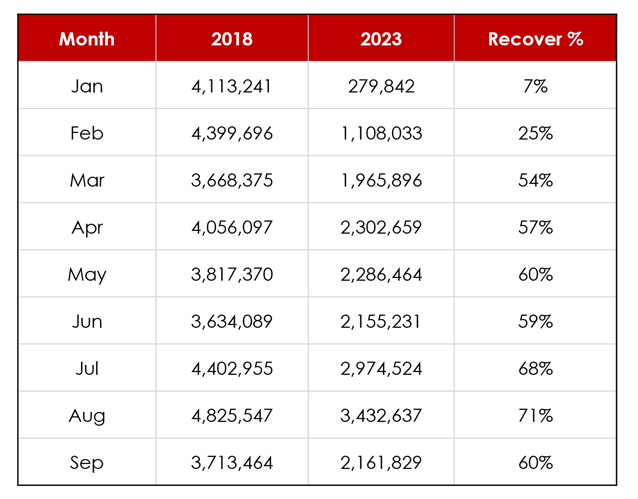
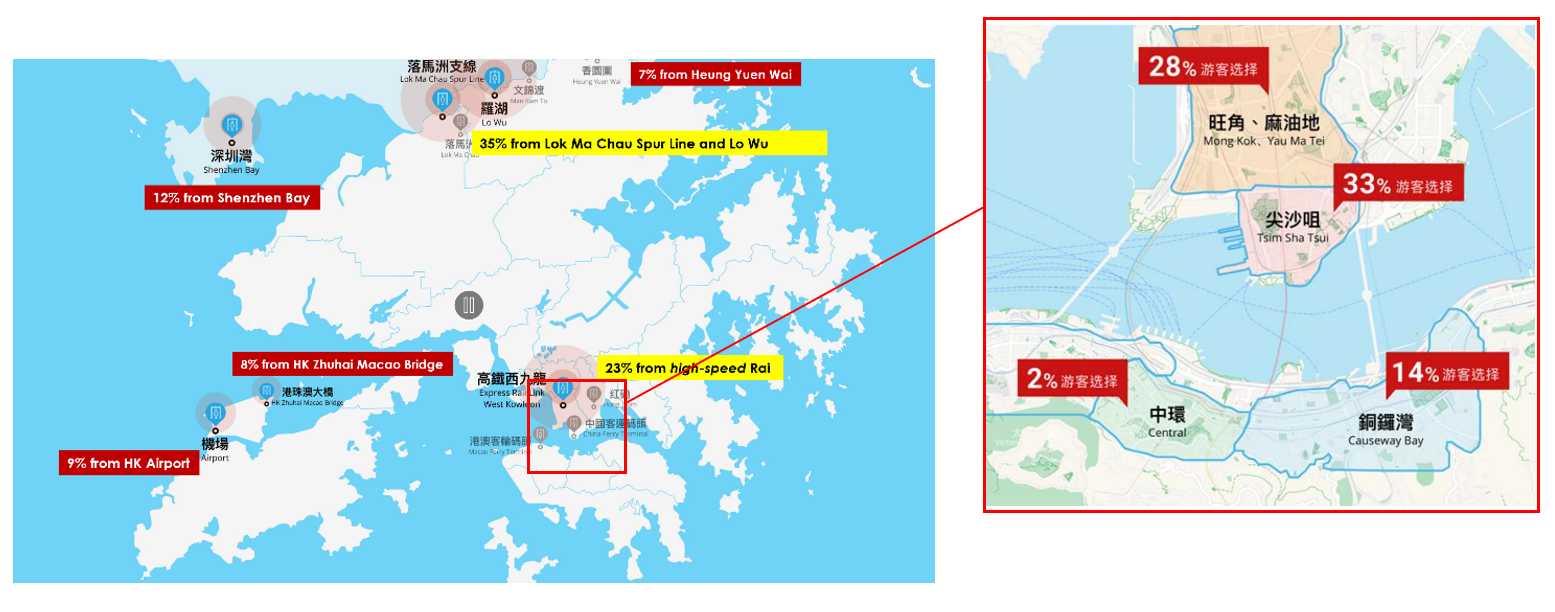
The statistics clearly show a noticeable increase in tourist arrivals from Mainland China in 2023, notably from the GBA—35% entered through the two Hong Kong-Shenzhen border checkpoints, while 23% arrived via high-speed rail. The statistics also reveal that a significant majority (77%) prefer to stay in accommodation located near the city’s main attractions, primarily in shopping districts such as Tsim Sha Tsui, Causeway Bay, and Mong Kok.
The GBA is a massive market for Hong Kong’s tourism industry. According to McKinsey, GBA tourists are spending an average of CNY¥36,400 (US$4,980) during their visits to Hong Kong in 2023.
However, its February 2023 survey conducted on 1,155 GBA tourists interested in visiting Hong Kong in 2023 revealed that 10-15% of them anticipate spending less in Hong Kong over the next three years. Instead, they are leaning towards Hainan or Macau for luxury shopping, and would turn to “Daigou” for products like cosmetics, health supplements, and infant formula.
The change in spending patterns is also reflected on the ground, too, where boutiques, especially in the beauty and skincare sector, have witnessed a decline in sales volume. This aligns with the broader trend of diminishing tourists’ interest in shopping in Hong Kong and instead displaying a greater preference for arts and cultural activities.
Why is this the case?

Why are Mainland Chinese tourists spending less in Hong Kong?
From the standpoint of the beauty and skincare sector, Hong Kong’s retail industry faces three prominent challenges.
Unfavorable Exchange Rate & Lagging Recovery
In September 2023, the Chinese Yuan hit a 10-year low against the Hong Kong dollar, making shopping in Hong Kong more expensive for Mainland Chinese tourists due to the unfavorable exchange rate. Additionally, China’s post-pandemic recovery is still sluggish, as evidenced by the 0.3% decline in the consumer price index in July 2023.
As such, the more expensive it is for Mainland Chinese tourists to shop in Hong Kong, the greater the incentive they need to purchase products.
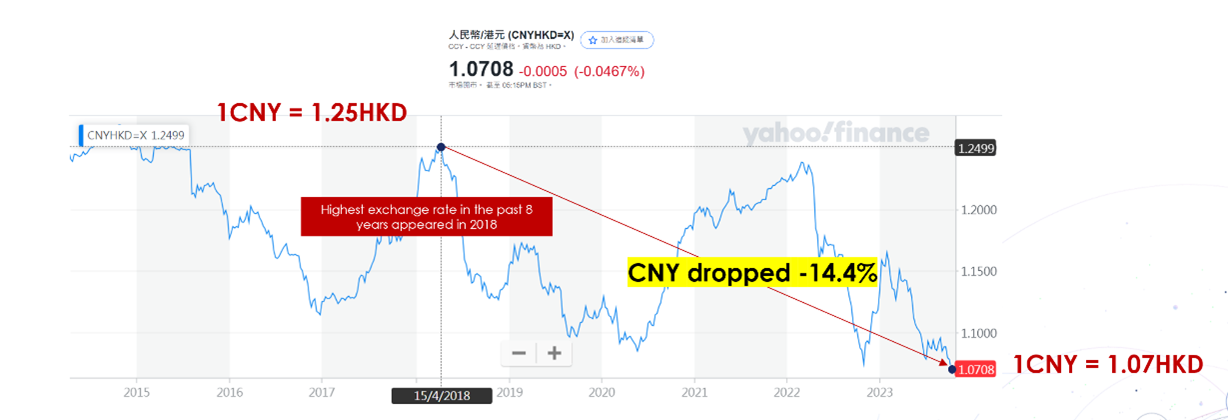
No SRP Advantage in Hong Kong
While the suggested retail price (SRP) for beauty products in Hong Kong is generally lower than in Mainland China by about 2-8%, this price difference is often not enough for many Chinese travelers to justify visiting Hong Kong solely for shopping. Consequently, there has been a decrease in product purchases made by Chinese tourists in Hong Kong.
At the same time, Chinese shopping platforms like Tmall are bridging the SRP gap by offering enticing discounts, often as high 50-55% off original pricing for beauty products. By implementing compelling promotional campaigns that offer unbeatable prices, they effectively entice local consumers to shop within Mainland China instead. This leads us to our final point.
Heavy Promotion in Mainland China and by DFS Hong Kong
The decrease in shopping volume by Mainland Chinese tourists in Hong Kong can be attributed to heightened competition from Mainland China. Notably, Mainland Chinese brands have excelled at running regular discount promotions and capitalizing on key shopping festivals—like “Double 11”—to push their offers.
One highly effective strategy they employ is leveraging their own sales staff as employee advocates. These employees promote products and offers on their personal social media accounts, functioning similarly to key opinion leaders (KOL) or key opinion consumers (KOC). By providing extra discounts ranging from 10-15% through affiliate links, in addition to the existing official discounts provided by the store, these employee advocates attract a significant customer base. Moreover, they tap into the popularity of off-the-table bulk purchases in China, offering substantial discounts of 45-55% off.
Meanwhile, DFS, as a competitor to local brands in Hong Kong due to its duty-free advantage, consistently provides exclusive deals to VIP customers, including Daigou shoppers, and implements targeted promotional strategies tailored to various audience segments.
What does this mean for Hong Kong brands?
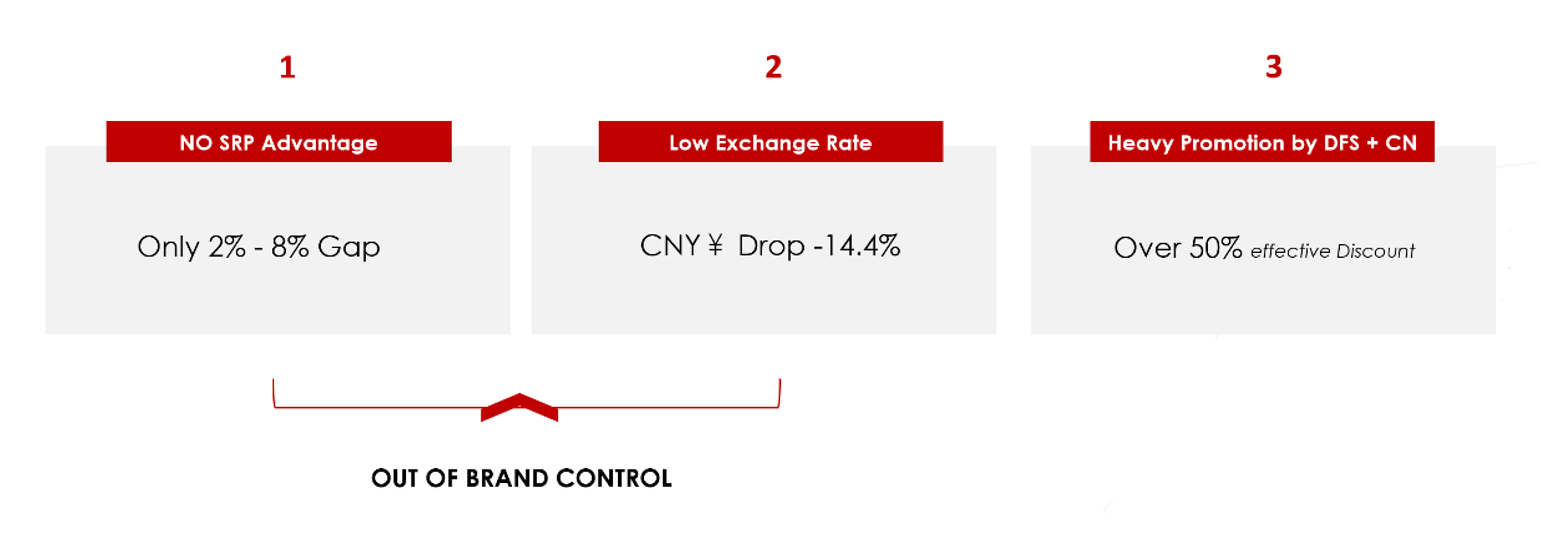
Among the various challenges that have contributed to the decrease in shopping by Mainland Chinese tourists in Hong Kong, the promotional obstacle stands out as one that Hong Kong brands can overcome.
By implementing their own travel marketing strategies that consider the current preferences of Chinese shoppers, these brands can attract a greater number of tourists and persuade them to choose their offers over competitors, whether in Mainland China or Hong Kong.

3 Travel Marketing Strategies to Convert Mainland Chinese Tourists
1. Create Irresistible Offers for Tourists
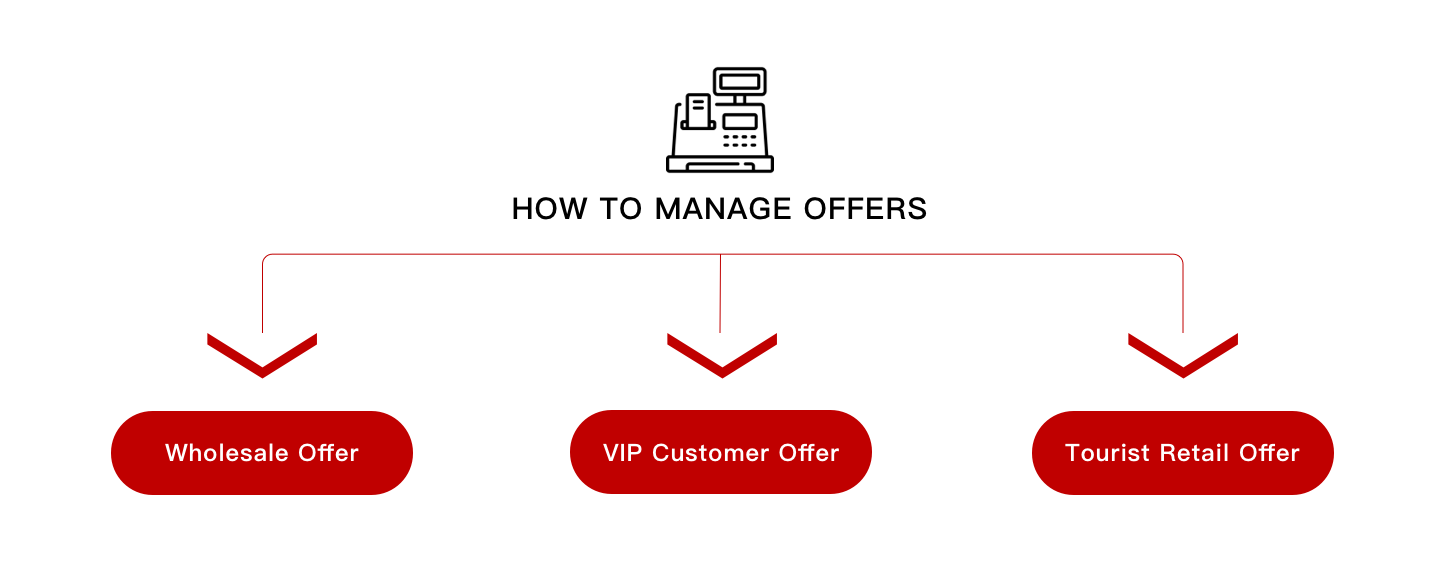
Creating the right offers for different tiers of customers is a must-do in Hong Kong’s beauty sector. Wholesale customers, VIP customers, and tourists represent distinct segments, each with their own preferences and purchasing behaviors that need to be considered.
When it comes to targeting tourists, beauty brands can expand their promotional efforts beyond official channels and create deep tourist campaigns. These campaigns aim to attract and engage tourists through “unofficial” channels—such as social media platforms, Mini Programs, and third-party landing pages accessible via an invitation code—that may not be visible on a brand’s official website.
The rationale behind this alternative approach is that beauty brands often encounter limitations in directly reducing their retail prices. However, through unofficial channels, they can still provide exclusive discounts or gift sets tailored for Chinese tourists while preserving their official pricing structure. This encourages customers to make online purchases and collect their products at the brand’s point-of-sales (POS), resulting in increased foot traffic and a higher likelihood of additional sales.
2. Sales-Driven Marketing Approach
Social Commerce (Online)
To entice both GBA residents and Hong Kong’s extended locals (i.e., Mainland Chinese residents currently residing in Hong Kong), brands should consider offering a hassle-free “Click & Collect” purchasing experience, facilitated by social commerce in the form of a WeChat Mini Program.
This approach allows tourists to easily make purchases on their phones and collect items at their convenience. They can choose to have friends pick up their purchases or personally retrieve them during their visits to Hong Kong, thereby aligning with their specific travel plans. Alternatively, they can have their items delivered to any address or pick-up location in Hong Kong and Macau, eliminating the need to carry purchases throughout their travels.
A Mini Program functions as a dedicated online storefront for brands on WeChat, ensuring a seamless shopping and checkout experience for users. Brands can then target offers and discounts to users in two ways: Proactively through WeChat push notifications or by collaborating with influencers, such as KOLs or KOCs, who work in partnership to promote the brand’s content on social media. These influencers also help by sharing the steps of the “Click & Collect” process with their audiences, making it easier for them to understand and follow.
By following or visiting a brand’s Mini Program, users are alerted to the opportunity of pre-ordering and pre-purchasing products with promo codes, unlocking even better offers.
Drive Purchases at POS (Offline)
In addition to social commerce, Hong Kong beauty brands can attract Chinese tourists by offering incentives that encourage potential customers to visit their physical POS locations.
For example, they can offer exclusive vouchers and synchronize the distribution on their WeChat Mini Program with promotional periods in Hong Kong. This enables Mainland Chinese tourists to benefit from discounted prices and the convenience of collecting their purchases from the brand’s POS in Hong Kong at a time of their choosing, even after the promotion period ends.
To ensure tourists can easily locate their POS locations, brands can develop a user-friendly store locator tool on their website, or accessible through their Mini Program. With just a single click, users can then access the most accurate and up-to-date information about the nearest stores. Additionally, they can implement a service booking feature on their Mini Program or website, allowing customers to easily schedule appointments for personalized shopping experiences or consultations.
3. Leverage Always-On Local Campaigns
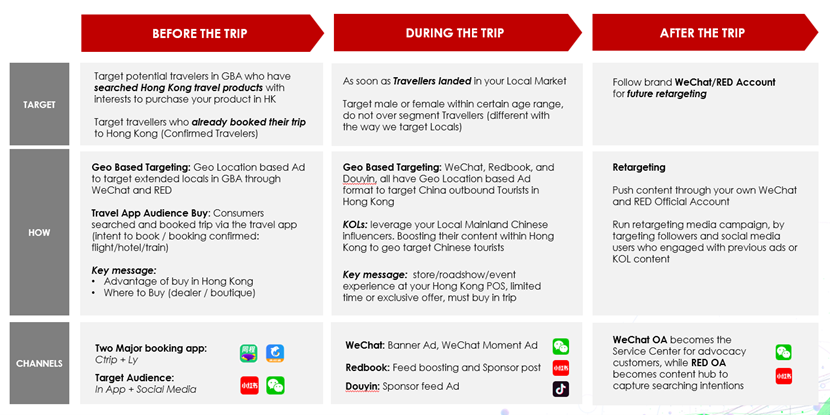
To ensure they remain at the forefront of their customers’ minds, it’s essential for brands to enhance their online visibility throughout the various stages of a traveler’s decision-making process: Pre-trip, in-trip, and post-trip.
• During the pre-trip stage, brands should establish a connection with potential GBA travelers interested in visiting Hong Kong by targeting users based on their recent booking behavior on popular travel booking apps, like Tongcheng and Ctrip. Utilizing the integration of these apps with top-tier social platforms, such as WeChat and RED, they can entice this audience with ad posts promoting shopping at their Hong Kong POS’. Additionally, they can leverage location-based ad targeting to reach extended locals who are active on those social platforms.
• During the in-trip stage, brands should prioritize targeting Mainland Chinese tourists who are currently visiting Hong Kong by utilizing geo-based targeting on platforms such as WeChat, RED, and Douyin. Collaborating with key opinion leaders (KOLs) can help amplify brand content to reach these tourists, while emphasizing timely or exclusive offers that are enticing and difficult to resist during their trip.
• In the post-trip stage, brands should prioritize increasing the number of travelers who follow their WeChat or RED official accounts for future retargeting purposes. By pushing content through these accounts and running retargeting media campaigns, brands can effectively target both general users and followers who have previously engaged with their ads or key opinion leader (KOL) content.
Finally, brands should consider incorporating programmatic ad buying throughout all travel stages to ensure improved and always-on targeting for their travel campaigns.
***
By incorporating these three travel marketing strategies, Hong Kong brands can enhance their value proposition to attract and convert more Mainland Chinese tourists.





